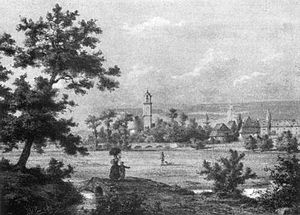Schönhof moated castle
| Schönhof moated castle | ||
|---|---|---|
|
Jakobskirche and Schönhof, 1855 |
||
| Alternative name (s): | Schönhof Castle, Schönhof, Schönhof zu Bockenheim | |
| Creation time : | unclear, first mentioned: 1575 | |
| Castle type : | Niederungsburg | |
| Conservation status: | gone, overbuilt | |
| Standing position : | Lower nobility, later money nobility | |
| Construction: | unknown, moated castle | |
| Place: | Frankfurt-Bockenheim | |
| Geographical location | 50 ° 7 '25.8 " N , 8 ° 38' 4.6" E | |
| Height: | 99 m above sea level NN | |
|
|
||
The moated castle Schönhof was a medieval moated castle , later a free aristocratic knight's farm or the Hofgut Schönhof in Bockenheim , an independent city until 1895 and today a district of Frankfurt am Main .
location
The castle was located approximately in today's area of Rödelheimer Straße 34 , opposite the confluence of Schönhofstraße and was built over by what would later become the Hofgut.
history
In 768 Bochinheim was mentioned for the first time in a Lorsch deed of donation . The place and castle belonged to the Dreieich Wildbann , later to the Bornheimer Berg county . A connection with the Bockenheimer Warte in the system of the Frankfurter Landwehr cannot be established. The moated castle was probably only the western protection of what was then Bockenheim. The castle belonged to the Knights of Praunheim until 1590 .
From 1730 to 1765 it was owned by the family of the banker Isaak d'Orville . He was raised to the nobility in 1743 by the German Emperor Charles VII, who had resided in Frankfurt for five years . The family was named "Edler von Löwenclau and Herr zu Schönhoffen". Since then, the name Schönhof has become established for the estate . In 1755, the Bergen Office at that time had the inscription 'Praedium equestre Schönhofianum' that had been placed over the gate of its Schönhof estate in Bockenheim removed.
The estate was sold to the Bruère family and burned down almost completely in 1818.
In 1819 it was acquired by the retired Minister of Hesse and Darmstadt . D. Carl Ludwig von Barckhaus called von Wiesenhütten . He commissioned the then very successful architect Nicolas Alexandre Salins de Montfort with the renovation. He had the manor house , which had been built between 1650 and 1700, renewed, part of the older residential and farm buildings demolished and replaced with spacious new buildings. A small theater was built next to the farm buildings (already demolished in 1937) and the estate's park was expanded. In 1820 the architect Friedrich Rumpf built a garden temple, which was moved to Grüneburgpark in 1964 . However, the new owner could not enjoy his property for long; he died childless in 1823, four years after the purchase. His heirs sold the Schönhof to the city of Frankfurt in 1898.
In 1872 the Schönhof became the western terminus of the first line of the Frankfurt tram . The horse-drawn tramway run by the Frankfurt Tramway Company ran from here through the city of Bockenheim and Frankfurt's Westend to the Hauptwache . For this purpose, a tram depot was built at Schönhof , which, in addition to the vehicles, also served as accommodation for the horses .
The tram line was later extended to Rödelheim . In order to defuse a hotspot of the accident, the Breitenbach Bridge (named after the Prussian Minister for Public Works, Paul von Breitenbach , 1850–1930) was built over the tracks of the Main-Weser Railway in 1914/16 . The park of the Schönhof fell victim to this construction measure.
During the Second World War , large parts of the Schönhof were destroyed during the air raids on Frankfurt am Main . Only the baroque mansion was rebuilt. Today the Greek restaurant "Dionysos" is located there. The large beer garden wants to remind of the park that has disappeared. In 1981 the manor house was repaired and next to it the City of Frankfurt built the Saalbau Schönhof, an award-winning music practice center, which is also used for events.
description
Traces of the castle are not preserved . Dates older than the end of the 16th century are not known. Under the corner of today's rebuilt mansion (originally at the end of the 17th century) there are still old vaulted cellars. The depression on the garden side was the Ochsengraben , which used to pass here and which had probably fed the existing but long-leveled surrounding trenches . The restored ensemble is a cultural monument .
Garden side of the manor house with today's beer garden in front of the restaurant
literature
- Rudolf Knappe: Medieval castles in Hessen. 800 castles, castle ruins and fortifications. 3. Edition. Wartberg-Verlag, Gudensberg-Gleichen 2000, ISBN 3-86134-228-6 , p. 397.
- Heinrich Ludwig: History of the village and the city of Bockenheim , Verlag Dr. Waldemar Kramer, Frankfurt am Main, 1940.
- Georg Dehio: Handbook of the German Art Monuments , Hessen II, Dt. Kunstverlag, 2008, p. 281.
Web links
- Schönhof Castle, City of Frankfurt am Main. Historical local lexicon for Hesse (as of July 23, 2012). In: Landesgeschichtliches Informationssystem Hessen (LAGIS). Hessian State Office for Historical Cultural Studies (HLGL), accessed on October 17, 2013 .
- Picture on www.frank66furt.de
- Entry on the aristocratic seat of Frankfurt (Bockenheim, Schönhof) in the private database "Alle Burgen".
- Historical plan of the Schönhof estate in Bockenheim from 1830
See also
- List of cultural monuments in Frankfurt-Bockenheim - Schönhof
- Saalbau Schönhof (Bockenheim) - music practice center
Individual evidence
- ↑ HStAM inventory 81 No. A / 400/9 Hessisches Staatsarchiv Marburg
- ^ Barkhaus called Wiesenhütten, Carl Ludwig Freiherr von. Hessian biography (as of October 18, 2010). In: Landesgeschichtliches Informationssystem Hessen (LAGIS). Hessian State Office for Historical Cultural Studies (HLGL), accessed on March 1, 2013 .









